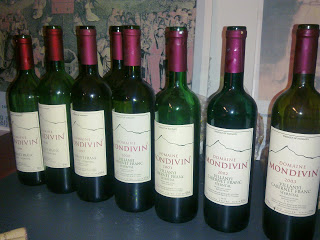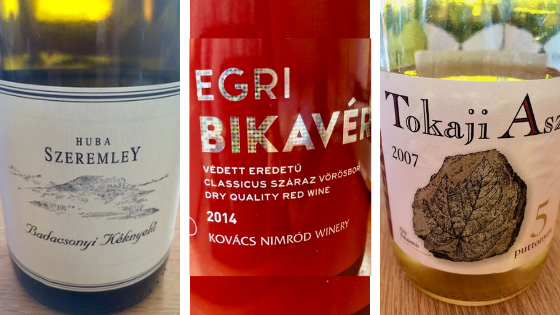Can one have only one love affair with a Hungarian wine? I fell in love with Hungarian wines several times, but of course, only one can be the first. In my case it was in 2012, when Hungary was on the tasting table at one of my wine tasting clubs and we tasted 7 vintages of the Cabernet Franc – Cabernet Sauvignon from the famous Domaine Mondivin, Villány.
The history of this Domaine dates back to the 1990s when Hungarian winemaker Ede Tiffán started his own business in Villány, 175 km south of Lake Balaton, an area mainly known for its red Cabernet Franc based wines. The winemaker was very talented and successful, so it soon became necessary to expand his activities. This is where Dutch Jan van Lissum came along. Together with the well-known (also Dutch) wine merchant Erik Sauter, he became co-owner of the company and Domaine Mondivin was born.
The vintages we tasted were 1994, 1995, 1999, 2000, 2001, 2002 and 2003.
The big difference between the vintages was striking.
Vertical tasting of Mondivin, my tasting notes
 The Mondivin 1994 is elegant and fragile, like a brave elderly lady. Tasteful. Red and dried fruit, slightly metallic, mildly spicy, mint, and also delicious red fruit in the aftertaste. In addition, the Mondivin 1995 is a bit more closed in the nose, has more blueberries, nutmeg, juniper, coffee and caramel and a bitter aftertaste. Such a big difference.
The Mondivin 1994 is elegant and fragile, like a brave elderly lady. Tasteful. Red and dried fruit, slightly metallic, mildly spicy, mint, and also delicious red fruit in the aftertaste. In addition, the Mondivin 1995 is a bit more closed in the nose, has more blueberries, nutmeg, juniper, coffee and caramel and a bitter aftertaste. Such a big difference.
The Mondivin 1999 has more fruit like plums, but for me it is a bit hollow in the mouth but with a fruity aftertaste. The Mondivin 2000 is a dark purple in color with ‘a lot of everything’ in the nose and mouth: ink, dark berries, plums, cassis but is a bit dusty too. The Mondivin 2001 has lots of red fruits, juniper, is fresh and smooth with a fresh, minty aftertaste.
We end this vertical tasting with the Mondivin vintages 2002 and 2003. This flight is very different than the others. Perhaps other vineyard techniques or methods have been applied here? Anyhow, the alcohol content of both wines is a higher than in previous vintages: 14.5% compared to 13-13.5%. The first wine, the Mondivin 2002, is a slightly lighter than the second, has a hint of cedarwood on the nose paired with red berries and (here again) the juniper. On the palate pepper, red fruit and some vegetal notes. A nice fresh aftertaste with blue fruit. In hhe Mondivin 2003 is a lot to experience. It has almost a port nose with blueberries, nutmeg and leather. The palate is a recall of the nose. The wine is jammy without being sweet. The tannins are still coarse. A powerful wine.
This memorable evening took place before I had ever visited any Hungarian wine region. Now I am happy to say I have visited several, travelling back and forth between The Netherlands, the country where I was born, and the country where I currently live, Romania. I learned a lot about Hungary as a wine country. And the diversity in wines and wine styles.
Driving through the Eger wine region
My first tasting in Hungary itself was in 2016. On our way to our house in Romania we made a pitstop in the Eger region. The first wine I fell in love with there was the Pinot Noir Monopole 2012 from Kovacs Nimrod. The grapes for the ‘Monopole’ wines come from their premier cru vineyards with granite and volcanic soils. When tasting their Rhapsody Egri Bikavér 2012 in their old cellar I understood that Egri Bikavér is much more (and better!) than the Egri Bikavérs I remembered buying in the supermarkets in the Netherlands in the time I was a student. Egri Bikavér appeared to be the top blend of a winery. Lesson learned!
On our way to the Tokay wine region we also visited the St. Andrea winery in Egerszalók and the Thummerer winery in Noszvaj, where we tasted beautiful wines from Hungarian grape varieties like Olaszrizling, Hárslevelű, Zenit, Furmint, and Rajnai rizling. By the way, when in Budapest: don’t forget to visit to the St. Andrea sky bar in the city center. Sky-highly recommended!
Sweetspot (but no only): Tokaj
When in Tokaj, one has to visit a winery that makes Aszú, one of the sweet wines the region is famous for. So we visited the Béres winery in Erdőbénye where we first tasted their dry Furmint 2014 and their famous oak-fermented, oak-aged Lőcse Furmint 2013, the estate’s top dry wine. After the Naparany 2013 (a Furmint – Hárslevelű blend) it was time for the sweet wines. We started with the Cuvée Magita, a late harvest blend of classical varieties of Tokaj followed by an impressive Tokaji Aszú 2007 5 puttonyos and the Late Harvest Yellow Muscat 2013. Another wine to fall in love with.
The Badasconi wine region
In autumn that same year, on our way back to The Netherlands we stopped at the Szeremley winery in Badasconytomaj, at the foot of the volcanic Badasconi hill north-west of the lake Balaton. Lazslo Szeremely, son of founder Huba, showed us around and learned us everything about the special volcanic terroir of the Badascony wine region and indigenous grape varieties like Kéknyelü, Bakator and Budai Zöld. Here we also tasted some wines from Pinot Noir, a grape Huba Szeremely (like me) had fallen in love with.
The Somló wine region
The last winery we visited before crossing the border with Austria was Kreinbacher, a wine producer famous for their sparkling wines, in Somló. The winery started with still wines in 2002 but since 2014 they produce their own sparkling wines, all made by the traditional method. After an interesting tour we tasted the Brut Classic (a blend of Chardonnay, Furmint, Pinot Noir and Pinot Blanc, 18-22 months on the lees) and the Brut Prestige (Chardonnay and Furmint, 24-30 months on the lees). We did not only taste these great sparkling wines, but also wines from indigenous grape varieties from the Somló region: Juhfark and Furmint, and beautiful blends of Olaszrizling, Furmint and Hárslevelű (Őreg Tőkék Bora 2013 and Kőkonyha 2009). We even finished with a fullbodied… Syrah!
There remains only one critical point… My husband asked me: “How is it possible that a decent woman like you falls in love so many times”. But after reading this article he understands.
The conclusion of my article: I visited beautiful and very diverse wine regions in Hungary, but never the Villány region, whose wines were “My first ‘love affair’ with a Hungarian wine”. But hooray! That will change soon: going to visit the Villány region twice this year! Keep you posted!
🍇🍷🍴Don’t want to miss any wine or other culinary news? Sign up here ✏️ for our weekly newsletter! Articles in Dutch and sometimes in English. But Google translate always helps!
#wijnreishongarije
#hongarije













Geef een reactie